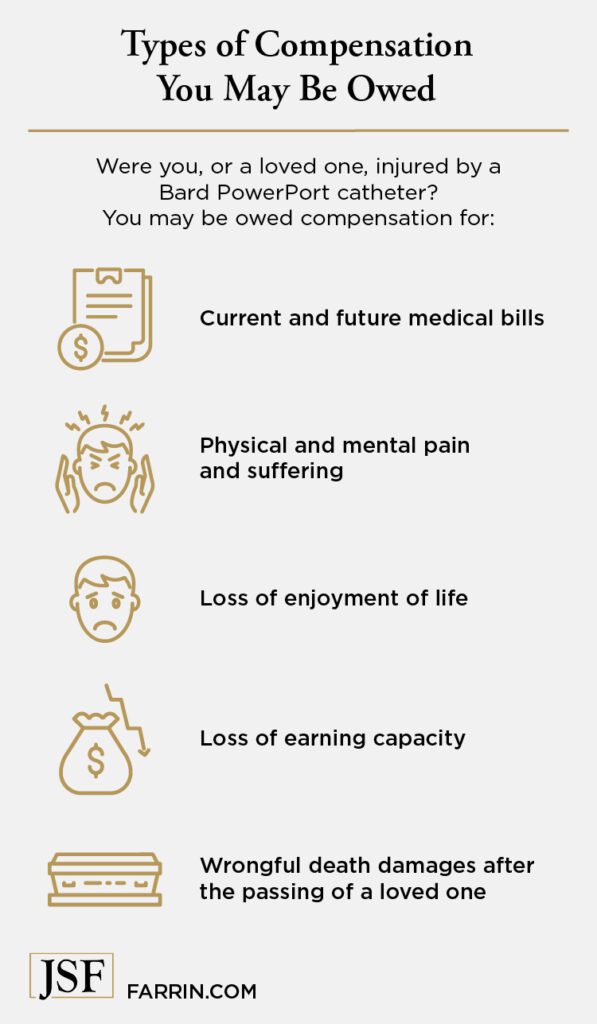Were you, or a loved one, seriously injured by a Bard PowerPort catheter?
Here’s what you need to know about the potential for injury with a Bard PowerPort catheter, the latest news, and how we can help if you’ve been injured.
Bard PowerPort Catheter Lawsuit: Are You Owed Compensation for Your Injuries?
The Bard PowerPort, or “BardPort,” is a catheter designed to go under the skin to help with providing fluids and medication to patients.
Unfortunately, the design of the Bard PowerPort is likely to have a high risk of complications, such as breaking or shifting from its intended position after it has been implanted – often causing serious, painful, and even deadly injuries to those that depend on it.
There is a great deal of litigation against the manufacturer of the Bard PowerPort. So far, the number of Bard PowerPort catheter cases has reached 322, and this number is expected to rise.
You may be entitled to significant compensation if you answer “yes” to these questions:
- Have you, or a loved one, ever had a Bard PowerPort catheter implanted?
- Has your, or your loved one’s, Bard PowerPort moved, shifted, or fractured since it was implanted?
- Have you, or a loved one, developed any infections or medical issues since having a Bard PowerPort implanted?
- Do you, or a loved one, feel significant pain or discomfort since having a Bard PowerPort implanted?
You may have many questions about your case. For a no-cost, no-obligation case evaluation, call 1-866-900-7078 today. We are here to help.
How the Bard PowerPort Often Malfunctions
The PowerPort is intended to help doctors access a patient’s bloodstream routinely in order to give them medicine, fluids, blood products, nutrition, and other vital supplies. It is put under the skin and should stay there.
The PowerPort has two main parts: an injection port and a flexible tube. The injection port has a raised center where a needle is put in to deliver fluids. The fluid then travels through the catheter into the bloodstream.
Chronoflex AL
The PowerPort’s catheter consists of a material called Chronoflex AL which is made of polyurethane, a type of plastic, and barium sulfate, which helps doctors see it in X-rays. However, the barium sulfate can cause the plastic to weaken over time, making the catheter more likely to break, move, or malfunction after being put into the body. The barium sulfate can also make the surface of the catheter bumpy and cracked, allowing bacteria to grow within and increasing the likelihood of infection and serious injury.
Complications With the Bard PowerPort
Lawsuits allege that the Bard PowerPort has major design and manufacturing flaws which can lead to three main problems after implantation:
Fracture: The most common issue is that the port can break under the skin, causing parts to fracture and get stuck in the surrounding blood vessels and tissue. This can lead to serious injuries.
Migration: The PowerPort can move out of place deep beneath the surface of the skin, leading to infection and injury.
Infection: The material that the catheter is made of can fracture and break, allowing bacteria to enter and cause serious and potentially deadly infections and sepsis.
Very soon after the PowerPort came out, Bard started receiving reports from doctors about fractures resulting in damage to tissue and internal blood vessels after the PowerPort was implanted.
In March 2020, the FDA recalled three PowerPort models because of problems like bloodstream infections, device movement, breakage, and blood clots.
Lawsuits from injured people also allege that Bard misled patients and doctors about the PowerPort’s safety. But after problems were reported, instead of fixing the device or issuing warnings, Bard kept marketing it. Now, patients with the PowerPort often don’t know about its potential dangers before allowing themselves to be implanted with it.
Injuries Linked to Defective PowerPorts
Common injuries caused by the Bard PowerPort breaking, moving, or malfunctioning include:
- Infection and sepsis
- Deep Vein Thrombosis (DVT), or blood clots
- Cardiac injuries
- Vascular damage, or damage to the veins
What Should I Do if I’ve Been Injured by My Bard PowerPort?
Your doctor may use several treatments to help you depending on the type and severity of your injury, including:
- Removal (and perhaps replacement) of the catheter
- Medications, including antibiotics and pain relievers
- Surgery to repair damaged tissues or blood vessels, or to remove pieces of a broken catheter
- Ongoing monitoring and wound care to promote healing and prevent infection
- Physical therapy and rehabilitation
When Should I Call an Attorney?
Call an attorney as soon as possible. An attorney can evaluate your case for free, answer your questions, and give you recommendations on what to do next. An experienced attorney can take the weight off your shoulders, advise you, and advocate for maximum compensation while you focus on your recovery.
You may be owed significant compensation that can help you and your family, including for:
- Your current and future medical bills
- Your physical and mental pain and suffering
- Your loss of enjoyment of life
- Your loss of earning capacity
- Wrongful death damages for the passing of a loved one
But don’t delay! If you wait, you may miss out on your opportunity for compensation and to hold Bard accountable for their behavior.
How James Scott Farrin Can Help With Your Bard PowerPort Lawsuit
If you, or a loved one, have suffered injuries from the Bard PowerPort catheter, it’s hard enough that you must endure the pain and danger of an infection – you shouldn’t have to pay for treatment, too. An attorney fights on your behalf and can significantly increase your odds of receiving maximum compensation.
We know how to help you. We’ve helped many clients who were harmed by defective drugs and products, such as:
- EzriCare Artificial Tears/Delsam Pharma Artificial Tears
- Surgical Staplers
- Philips CPAP, BiPAP, and Ventilators
- Hair relaxing products
- Injectafer
- Hip Implants
- Exactech replacement joints
- Tepezza
- Elmiron/Pentosan
- Xeljanz
- And many others
If you, or a loved one, were harmed by your Bard PowerPort catheter, then contact us today at 1-866-900-7078 for a free case evaluation.



